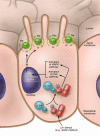Acid sensing in renal epithelial cells
- PMID: 15599393
- PMCID: PMC535075
- DOI: 10.1172/JCI23864
Acid sensing in renal epithelial cells
Abstract
The kidney adjusts net acid excretion to match production with exquisite precision, despite little or no change in the plasma bicarbonate concentration. The acid-sensing pathway that signals the kidney to increase acid secretion involves activation of the proto-oncogene c-Src. A new study in this issue shows that proline-rich tyrosine kinase 2 (Pyk2) is responsible for acid-induced activation of c-Src and is essential for acid sensing in renal epithelial cells. The findings implicate a broader role for Pyk2 in acid-base homeostasis in bone and other tissues beyond the kidney.
Figures

Comment on
-
Pyk2 activation is integral to acid stimulation of sodium/hydrogen exchanger 3.J Clin Invest. 2004 Dec;114(12):1782-9. doi: 10.1172/JCI18046. J Clin Invest. 2004. PMID: 15599403 Free PMC article.
Similar articles
-
A central role for Pyk2-Src interaction in coupling diverse stimuli to increased epithelial NBC activity.Am J Physiol Renal Physiol. 2002 Oct;283(4):F663-70. doi: 10.1152/ajprenal.00338.2001. Am J Physiol Renal Physiol. 2002. PMID: 12217857
-
PYK2 in osteoclasts is an adhesion kinase, localized in the sealing zone, activated by ligation of alpha(v)beta3 integrin, and phosphorylated by src kinase.J Clin Invest. 1998 Sep 1;102(5):881-92. doi: 10.1172/JCI3212. J Clin Invest. 1998. PMID: 9727056 Free PMC article.
-
(alpha)v(beta)3 integrins and Pyk2 mediate insulin-like growth factor I activation of Src and mitogen-activated protein kinase in 3T3-L1 cells.Mol Endocrinol. 2005 Jul;19(7):1859-67. doi: 10.1210/me.2004-0481. Epub 2005 Mar 10. Mol Endocrinol. 2005. PMID: 15761030
-
Pyk2 activation is integral to acid stimulation of sodium/hydrogen exchanger 3.J Clin Invest. 2004 Dec;114(12):1782-9. doi: 10.1172/JCI18046. J Clin Invest. 2004. PMID: 15599403 Free PMC article.
-
A role for Pyk2 and Src in linking G-protein-coupled receptors with MAP kinase activation.Nature. 1996 Oct 10;383(6600):547-50. doi: 10.1038/383547a0. Nature. 1996. PMID: 8849729
Cited by
-
Regulation of transport in the connecting tubule and cortical collecting duct.Compr Physiol. 2012 Apr;2(2):1541-84. doi: 10.1002/cphy.c110052. Compr Physiol. 2012. PMID: 23227301 Free PMC article. Review.
-
Physiological carbon dioxide, bicarbonate, and pH sensing.Pflugers Arch. 2010 Nov;460(6):953-64. doi: 10.1007/s00424-010-0865-6. Epub 2010 Aug 4. Pflugers Arch. 2010. PMID: 20683624 Free PMC article. Review.
-
Sensing, physiological effects and molecular response to elevated CO2 levels in eukaryotes.J Cell Mol Med. 2009 Nov-Dec;13(11-12):4304-18. doi: 10.1111/j.1582-4934.2009.00952.x. Epub 2009 Oct 23. J Cell Mol Med. 2009. PMID: 19863692 Free PMC article. Review.
-
Transcriptional regulation of the pendrin gene.Cell Physiol Biochem. 2011;28(3):385-96. doi: 10.1159/000335100. Epub 2011 Nov 16. Cell Physiol Biochem. 2011. PMID: 22116353 Free PMC article. Review.
-
Clinical review: Renal tubular acidosis--a physicochemical approach.Crit Care. 2005;9(6):573-80. doi: 10.1186/cc3802. Epub 2005 Aug 25. Crit Care. 2005. PMID: 16356241 Free PMC article. Review.
References
-
- Kurtz I, Maher T, Hulter HN, Schambelan M, Sebastian A. Effect of diet on plasma acid-base composition in normal humans. Kidney Int. 1983;24:670–680. - PubMed
-
- Nagami GT. Ammonia production and secretion by the proximal tubule. Am. J. Kidney Dis. 1989;14:258–261. - PubMed
-
- Hamm LL, Hering-Smith KS. Pathophysiology of hypocitraturic nephrolithiasis. Endocrinol. Metab. Clin. North Am. 2002;31:885–893, viii. - PubMed
Publication types
MeSH terms
Substances
LinkOut - more resources
Full Text Sources
Miscellaneous

